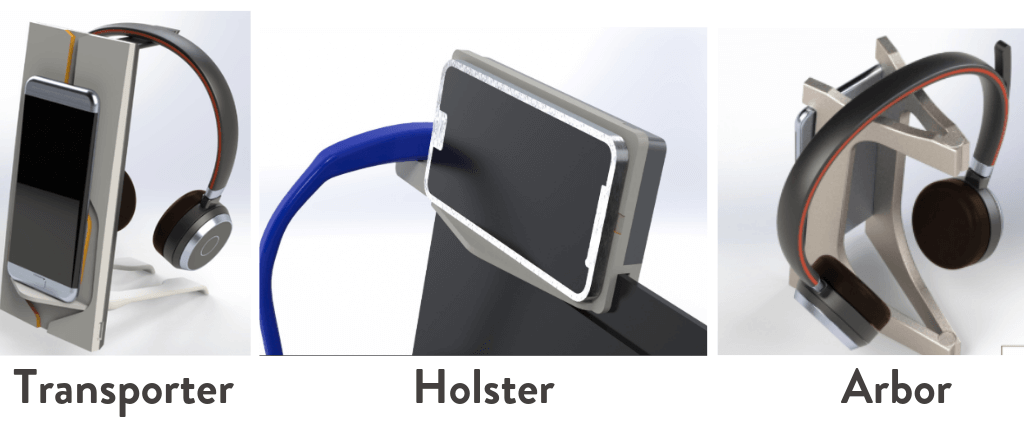Overcoming Engineering Challenges | Design to Manufacturing Series (Part 3)
 Having a functional workspace that’s also neat and clutter free may seem unrealistic or temporary at best. Cell phones, computers, tablets, headsets – there just doesn’t seem to be enough room for it all! Over the course of the next eight months, the team of Application Engineers at Fisher Unitech is tackling this problem head-on overcoming engineering challenges with the goal to offer a solution that we can all use for desktop management and organization.
Having a functional workspace that’s also neat and clutter free may seem unrealistic or temporary at best. Cell phones, computers, tablets, headsets – there just doesn’t seem to be enough room for it all! Over the course of the next eight months, the team of Application Engineers at Fisher Unitech is tackling this problem head-on overcoming engineering challenges with the goal to offer a solution that we can all use for desktop management and organization.
In part one, we introduced the project plan as well as the tools we’ll use to execute our design including the entire suite of SOLIDWORKS 3D CAD products as well as additive manufacturing technologies such as 3D printing and 3D scanning. In part two, we ran through different design concepts that serve as both functional and creative. In this blog, we share which concepts we eliminated.
After a full team review, the Arbor, Transporter, and Holster industrial design concepts have been selected for further development. While each design carries the same family aesthetic, each offers unique functional elements that present some engineering challenges.

Electrical Challenges
The headset and cell phone stand will incorporate a wireless cell phone charger so the electronics must reside within a certain distance and orientation to the wireless receiver in the cell phone for an efficient charge. Depending on what cell phone you have, the location of the receiver can vary – some are centered while others are biased to a side – regardless, there’s no clear indication as to where the receiver is located on the back of your phone.
The challenge to engineering is to select the appropriate layout that can accommodate multiple cell phone brands while maintaining the ability to charge effectively through a protective cover. To handle these challenges, various options must be considered:
- Using a dual charging coil for interoperability
- Design for a select few cell phone models and offer specific configurations of the stand varying the charger location
- Incorporate adjustability into the design – either moving the phone’s location on the charger or moving the charger component within the housing
The stand will also accommodate hard-wired charging. The support for the cell phone will give ample access to the micro USB port at the bottom of the phone to plug in the phone charging cable.
Illumination and Indicator Light Challenges
The family aesthetic includes illumination both as a design element and as feedback to the charging status. We’ll need to use a series of LED’s to illuminate the stand and to indicate when charging is in process and when it is complete.
Cable Storage Challenges
The headset and cell phone stand should provide storage of the headset cord and/or the charging cord while not in use. It could also serve as a method to shorten the cord if desired.
Center of Gravity, Weight Distribution, Hinging Arms, Locking Mechanisms, and Cantilevers
The challenge here is that the physical properties of the weight and location of the components will have a direct effect on the stability of the system. Because of this, the design and reinforcements should be able to securely support the cell phone and headset without compromising the structural integrity of the holder.
Clamping or Mounting Considerations
The design of our mounting system must accommodate a wide variety of thickness of laptop monitors and free-standing computer monitors. We have made the assumption that laptop monitor thickness can vary from .15”-.45” (the thickness of a 2015 MacBook Pro monitor is 0.19” and the thickness of a 2013 Dell M6800 Precision monitor is 0.370”).
The mounting system must be robust enough to secure the stand, phone, and headset, while not marring the surface of the monitor. The design of the mounting system could include increasing the length along the top of the monitor, increasing the support on the backside of the monitor, and using a spring clip or equivalent to accommodate different monitor thicknesses.
Cell phone Challenges
The challenge we’ll face with our cell phone is that it is preferable to have it be orientated in portrait format and located at a comfortable eye level.
Headset Challenges
Our headset stand must accommodate a wide range of over the head, lightweight-midrange headsets with a microphone. To help us with this, our Application Engineers digitally scanned a mid-range headset. The scanned database and weight will be used in the virtual prototypes to simulate and analyze the physical loads and stresses placed on the product.
To get an exact representation of the headset we used the Artec Space Spider 3D Scanner, a small lightweight, handheld 3D scanner that we selected due to its ability to capture intricate details with maximum accuracy and speed. There is no special preparation required for 3D scanning, simply point the scanner at your model in various orientations to capture all the necessary details. (Learn more about how 3D scanners work, applications, and cost here).
When you’re finished scanning, the scans are loaded into the scanner’s provided software for cleanup and alignment. We can save the geometry in a variety of familiar mesh formats to be included in the headset and cell phone stand design.
Up next in our Design to Manufacturing series, we’ll continue to look at mechanical design iterations and prototypes. Stay tuned!
Related Articles
Concept Creation | Design to Manufacturing Series (Part 2)
Introduction to the Fisher Unitech Design to Manufacturing Series
About the Author

Laura Nickerson is an Application Engineer with Fisher Unitech. She has 17 years of experience in the consumer appliance industry working as an industrial designer and mechanical designer. Laura is detail-oriented, a problem solver, and is listed as co-inventor in over 40 patents.
Additional Contributors
 David Janicki is an Application Engineer based out of our office in Grand Rapids, MI. He is a proud graduate of Western Michigan University, where he received his Bachelors in Engineering Management. Prior to joining Fisher Unitech in November 2015, David worked in various industries from Automotive and Sheet Metal to Electronic RFID’s. A large portion of his background is in the Continuous Improvement industry and still continues to be his passion, helping customers use the software more effectively both on a user and company level.
David Janicki is an Application Engineer based out of our office in Grand Rapids, MI. He is a proud graduate of Western Michigan University, where he received his Bachelors in Engineering Management. Prior to joining Fisher Unitech in November 2015, David worked in various industries from Automotive and Sheet Metal to Electronic RFID’s. A large portion of his background is in the Continuous Improvement industry and still continues to be his passion, helping customers use the software more effectively both on a user and company level.
 James Reeher has a Bachelor of Science in Mechanical Engineering from Cleveland State University and began using Solidworks in 2007. After many years as a Product Development Engineer in the industrial fitting, biomedical device, and LED lighting industries he joined the Fisher Unitech team in 2016. James is very interested in new technology and how different technologies can be applied to one another. As an Application Engineer, he enjoys helping customers learn how to leverage Solidworks to meet their needs and introduce them to other technologies that can help their business.
James Reeher has a Bachelor of Science in Mechanical Engineering from Cleveland State University and began using Solidworks in 2007. After many years as a Product Development Engineer in the industrial fitting, biomedical device, and LED lighting industries he joined the Fisher Unitech team in 2016. James is very interested in new technology and how different technologies can be applied to one another. As an Application Engineer, he enjoys helping customers learn how to leverage Solidworks to meet their needs and introduce them to other technologies that can help their business.

 Blog
Blog